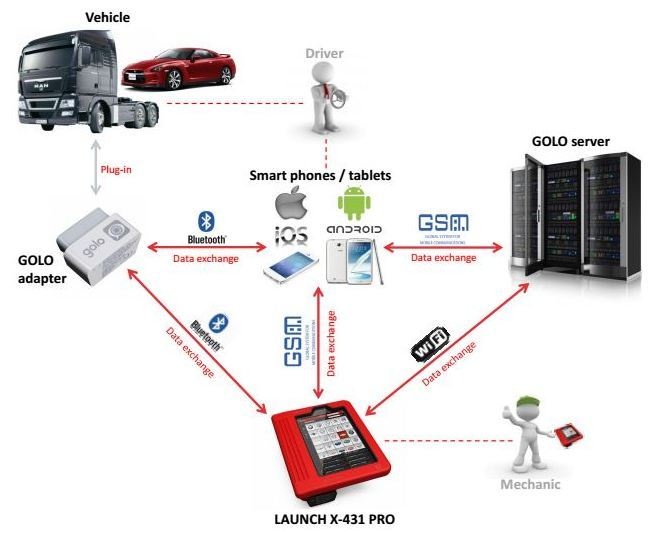Remote vehicle diagnostics (RVD) is steadily appearing as a potentially unavoidable next step in the technological development of the automotive industry, with the promise of reduced outlay on warranty, product improvement and marketing acting as a convincing value proposal.
Further benefits of the emerging RVD technology will be manifested in the creation of competitive advantage through product differentiation and the ability to provide improved after-sales service and support to customers.
The advent of RVD will present vehicle manufacturers with the opportunity to step into the middle of their distribution and after-sales value chain, thus developing closer relationships with their customer base. Automotive manufacturers’ retention of control over their after-sales service value chain is of strategic importance in view of the implementation of the new competition laws in Europe.
Apart from the benefits of remote diagnostics for passenger vehicle owners, the technology holds tremendous potential for cost-savings and process improvements for fleet owners and vehicle manufacturers, according to latest findings unveiled by Frost & Sullivan, the international marketing consulting company, today.
Cost-savings of just one per cent can significantly boost motor companies’ bottom line – considering the scenario where vehicle manufacturers’ expenditure on developing a top-range car – from design to roll-out – stands at between €2.5 billion to €3 billion. Furthermore, the study stresses that fleet operators will be able to reap benefits from the minimization of vehicle breakdowns and heightened efficiency of maintenance activities.
However, due to the technology’s nascence, vehicle manufacturers are cautious to announce ambitious plans concerning the introduction of RVD and associated services. A number of technical and commercial issues such as prohibitively high infrastructure costs (particularly telecoms), the management of technological obsolescence of component technologies and limited bandwidth, remain unresolved and must be addressed to enable the technology to fully evolve and flourish.
Anil Valsan, Research Analyst at Frost & Sullivan, says: “Despite the embryonic stage of the RVD market, almost every vehicle manufacturer, be it for passenger or for commercial vehicles, has the technology and service on their near- or medium-term introduction plan.”
Following a spate of introductions over the next two years, the European remote vehicle diagnostics market will hit the zenith of its growth and climb to reach 5.38 million units by 2009.
In terms of revenues, the market will display above average growth rates, set to rise from €180.51 million in 2001 to €1.88 billion by 2009. The passenger vehicle market is expected to account for a whopping 95 per cent of revenues by the end of the forecast period.
The rapid growth in the units installed during the forecast period presents vehicle manufacturers, telematics system suppliers and service providers a tremendous opportunity to take advantage of being the market pioneers.
Frost & Sullivan expects momentum behind remote diagnostics installations in commercial vehicles to be sustained by the fleet management benefits RVD offers. Moreover, the remote diagnostics service is likely to be packaged along with fleet management systems introduced in commercial vehicles, and hence the in-vehicle hardware is likely to become a commonplace feature.
The nature of the remote diagnostics service is expected to evolve from passive and periodic diagnostics to vehicle-initiated fault notification and prognostics. Initially launched as a read-only option, where diagnostic trouble codes are deciphered by data centre staff, Frost & Sullivan believes that the service will make its debut in top-of-the-range vehicles in the luxury and executive segment vehicles.
The simultaneous introduction by different manufacturers – such as BMW, Fiat, Volvo, and PSA – and the benefits of the quality of the service are likely to drive the market penetration in these vehicle segments from 2003 onwards. Vehicle manufacturers are then gradually expected to introduce the service between 2004 and 2005 in the upper-medium vehicle segment as an optional feature.
Across lower segment vehicles, RVD will be available only as an optional feature over the forecast period, and installations will depend on the attractiveness of the overall package offered to the customer.
Mr. Valsan continues: “We believe that remote diagnostics is not likely to be introduced on its own, but is likely to be bundled in a package along with other telematics services. As a result, even on the hardware front, vehicle manufacturers are expected to use the telematics unit installed in the vehicle to perform the necessary computations and communication for the remote diagnostics services as well.”
The study warns that both commercial and passenger vehicle manufacturers will have to undertake restructuring exercises, both internally as well as in their distribution and after-sales service chains, in order to effectively utilize the remote diagnostics system.
While the passenger vehicle market is likely to see the vehicle manufacturers retaining control over the data and protecting its confidentiality, the commercial vehicle manufacturers are expected to witness a lot more cooperation to achieve standardization of diagnostic codes and communication protocols.
The passenger vehicle market is likely to see remote diagnostics systems being introduced under the brand names of the respective vehicle manufacturers, irrespective of whether the service is managed by their own division or outsourced to a third-party company.
While the passenger vehicle market is likely to see companies like DaimlerChrysler, BMW and the Fiat Group, the Lancia and Alfa Romeo brands, spearheading the introduction of remote diagnostics in Europe, the commercial vehicle market is forecast to witness DaimlerChrysler, Volvo and Scania leading the market launch of this technology.
Apart from vehicle manufacturers, the vertical value chain participants are likely to drive the standardization of communication protocols, software components and in-vehicle networks, the study concludes.

Vehicle Remote Diagnostics Realization: A New Age for Auto Makers
by
Tags:

Leave a Reply